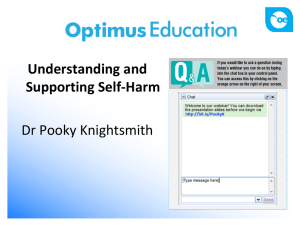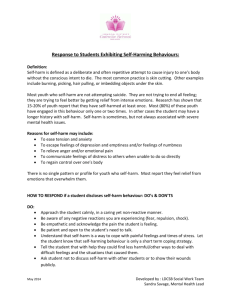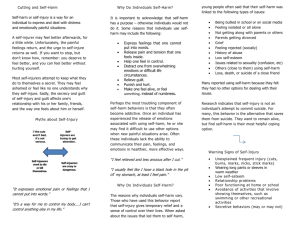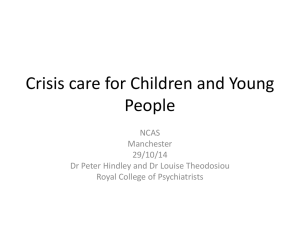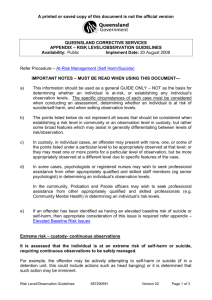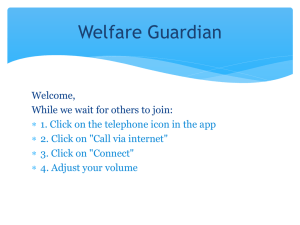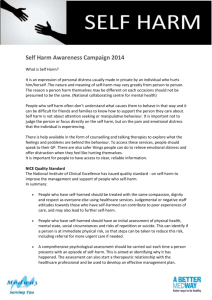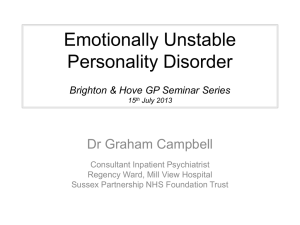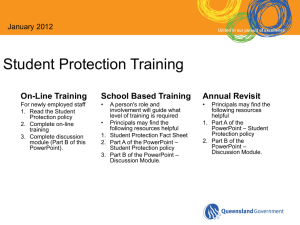Understanding Self Harm Resource Pack
advertisement
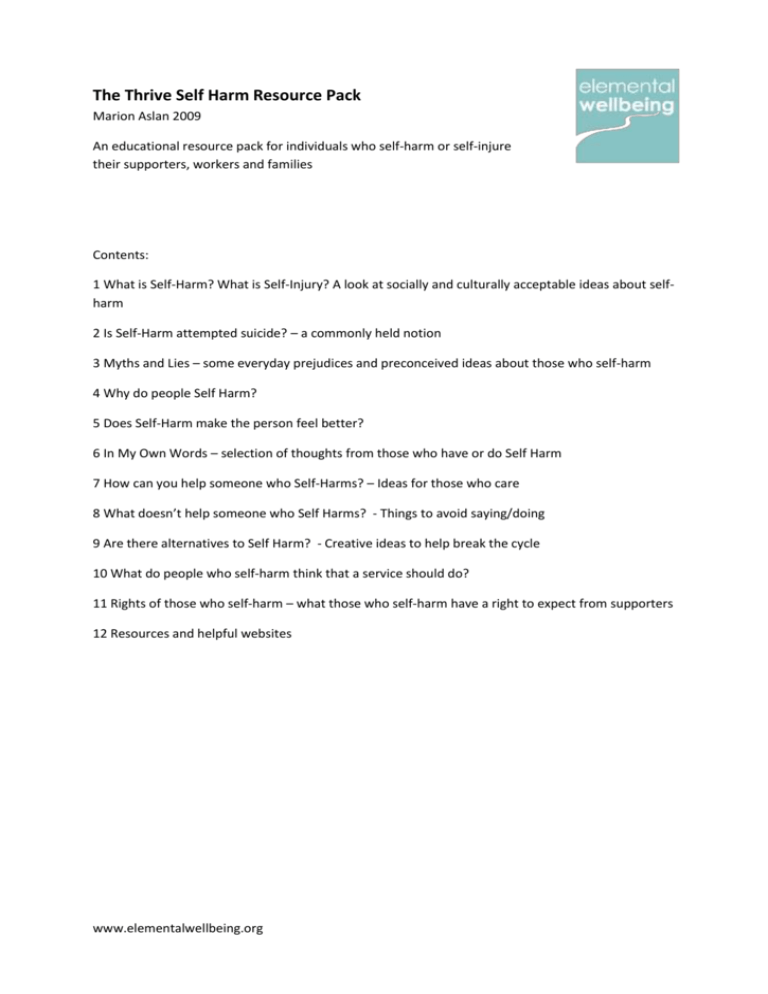
The Thrive Self Harm Resource Pack Marion Aslan 2009 An educational resource pack for individuals who self-harm or self-injure their supporters, workers and families Contents: 1 What is Self-Harm? What is Self-Injury? A look at socially and culturally acceptable ideas about selfharm 2 Is Self-Harm attempted suicide? – a commonly held notion 3 Myths and Lies – some everyday prejudices and preconceived ideas about those who self-harm 4 Why do people Self Harm? 5 Does Self-Harm make the person feel better? 6 In My Own Words – selection of thoughts from those who have or do Self Harm 7 How can you help someone who Self-Harms? – Ideas for those who care 8 What doesn’t help someone who Self Harms? - Things to avoid saying/doing 9 Are there alternatives to Self Harm? - Creative ideas to help break the cycle 10 What do people who self-harm think that a service should do? 11 Rights of those who self-harm – what those who self-harm have a right to expect from supporters 12 Resources and helpful websites www.elementalwellbeing.org What is Self-Harm? What is Self-injury? Self harm can be difficult to define as it covers a broad spectrum. Most of us at some point in our lives will engage in some sort of self harming behaviour without necessarily identifying it as such overindulgence of food or alcohol, unhealthy relationships, excessive dieting, cosmetic surgery etc. There are a range of things on the continuum of self harm that if taken to extremes can be detrimental to emotional, physical and spiritual health. For those who enter into the mental health sphere it is usually this excess that is the problem – e.g. substance misuse or the fact that their method of self-harm is not culturally acceptable. In general terms, self- harm could be said to be any act that either causes harm to the self or where harm results because the person has deliberately chosen not to do something to maintain good health e.g. omitting to take essential medications for physical health problems. Self-Injury occurs where there is a deliberate damaging of body tissue without the conscious attempt to commit suicide e.g. cutting or burning. Psychiatry has long since focussed on the emotive area of self-injury and there has been an irrational focus on behaviour and physical damage to the body, there is little evidence of any great difference between the two apart from the obvious that self-injury damages the body and self-harm is just a more inclusive term which includes self-injury. Some acts of self-harm can be more easily hidden than others – for example insertion, overdosing, self - strangulation asphyxiation etc. though many people who self-injure may keep their injuries hidden. For the purposes of this resource pack and toolkit the inclusive use of the term self-harm will be used to denote both self-harm and self-injury, unless otherwise specified. Self-harm is a way of expressing very deep distress that you can’t always put into words or even thoughts. It’s been described as ‘an inner scream’, a way of communicating inner turmoil. It is not restricted to a small part of the population but it is part of everyday experiences of most of us. Selfharm encompasses many things and some are more culturally acceptable than others. Piercing and tattoos are seen as not only acceptable but commonplace and whereas few women prior to the 80’s would have dreamed of getting a tattoo, current figures from Reuters for the USA indicate more women (59%) than men (41%) now get tattooed. Cultural acceptability changes, then, over time and geographical location. Cutting one’s arms or legs is more difficult for people to understand in the Western world though in parts of the globe these and other acts are generally culturally acceptable such as: • • • • • • • • Neck stretching Tattooing Facial scarring Crucifixion Lip plates Piercing Flagellation Starvation (fasting) www.elementalwellbeing.org “The term self-injury is a broad one which can be applied to the actions of many people at some time in their lives. Much behaviour which are culturally acceptable can result in self-inflicted physical and psychological damage, notably smoking, excessive alcohol consumption, over-eating or dieting. Selfinjury can, and does, also occur as a legitimate part of various religious practices, or forms of social or political protest or statement.” NICE 2003 In short, self-harm is acting against your own well-being and can be seen as any harmful act to the self, directly or by omission, in which the direct intent is not to die. Self-Harm may include: • • • • • • • • • • • Burning or cutting yourself Scratching or picking the skin Hitting yourself against or with objects Taking too much medication or drugs Swallowing objects or dangerous fluids Inserting objects inside the body Staying in abusive relationships Eating difficulties Hair pulling Drinking or smoking to excess Not taking good care of your own emotional or physical needs Self-Harm takes place regardless of race, gender, sexual orientation and religious views. It is often found when people have had distressing life experiences or experienced a significant traumatic event. These experiences may have overwhelmed the individual and may have not been fully resolved. Sometimes there are feelings of frustration and anger because the traumatic episodes or distressing events have not been believed (as in the case of childhood sexual abuse). As many people who self-harm do not tell anyone about it or the underlying problems or attend hospital to have their wounds treated, statistics are likely to underestimate how widespread selfharm is. There has been a growing concern around the number of young people self-harming. Research carried out by the organisation Young Minds re figures for the UK show that:• 1 in 12 young people self-harm. • In 2013 there were 38,000 young people who were admitted to hospital because of their injuries. • Inpatient admissions due to young people self-harming increased by 68 per cent in the last 10 years. These figures are just the tip of the iceberg as many young people who self-harm do not come to the attention of services. A report containing the results of the study states that it’s not just health care professionals who think self-harm is on the increase – teachers can feel that the secrecy surrounding the subject. One deputy head reported “I’m dealing with more cases of students self-harming than I have done at any other time in my career. Other teachers here wouldn’t have any idea of how common it is. We’re really careful to prevent that kind of thing leaking out; it’s on a ‘need to know’ basis” www.elementalwellbeing.org Oxford researchers have found that although internet forums provide a support network for socially isolated young people, the internet is also linked to an increased risk of suicide and self-harm among vulnerable adolescents. Those who are involved in self-harm may often display one or more of the following characteristics: • A tendency to strongly dislike/invalidate themselves • Hypersensitive to rejection • Are chronically angry, usually at themselves • Tend to suppress their anger • Have high levels of aggressive feelings of which they strongly disapprove and often suppress or direct inward • Are more impulsive and more lacking in impulse control • Tend to act in accordance with their mood of the moment • Tend not to plan for the future • Are depressed and suicidal/self-destructive • Suffer chronic anxiety • Tend toward irritability • Do not see themselves as skilled at coping • Do not have a flexible repertoire of coping skills • Do not think they have much control over how/whether they cope with life • Tend to be avoidant of certain situations/relationships • Do not see themselves as empowered Is Self-harm attempted suicide? Even within mental health services, self-harm can be misinterpreted as attempted suicide. Whereas suicide is a deliberate act, with direct intent to end one’s own life, self-harm is very much a survival strategy rather than ending life. People who hurt themselves repetitively do have an increased lifetime risk of suicide but the relationship between the two is poorly understood, indeed many people who self-harm describe the harm as a way of surviving or coping - quite the opposite of suicide. It is apparent that those things that people are trying to cope with or understand or express may also lead a person to hopelessness at some time and this may explain some of the links to suicide. When a person changes a long established method or a new one, i.e. a person who cuts suddenly starts to poison or asphyxiate, it is appropriate to consider the possibility of hopelessness and suicidal thoughts/ intents creeping in. www.elementalwellbeing.org It can be important because often people’s self-harm is ignored by services and they then treat the person who is hopeless and suicidal with ignorance because they don’t understand the changing situations and the person is left alone. Self-harm is a way of coping with inner pain. It is a release, so that the person concerned can have control over their pain and go on living. It is suggested that self-harm is the opposite of suicide and indicates a determination to cope with extremely difficult situations and emotions. “While it is true that people who consider suicide and take their own life may also self-injure, it is commonly accepted that self-injury is not about dying and does not have suicidal intent. People who self-injure may be desperate to end the distress that they are suffering, but self-injury can be thought of as a survival strategy. People may feel that their use of self-injury keeps them alive. This self-injury is sometimes considered the opposite of suicide.” Life SIGNS Self-Injury Awareness Booklet 2007 “Self-harm is about trying to stay alive, despite the pain people are in. Although there is a relationship between self-harm and suicide, many more people self-harm than kill themselves, and most people don’t hurt themselves so badly as to risk their lives. Of those who do, suicide may not have been their intention; it’s the feelings they want to wipe out…. “ MIND “Self-injury is a way of carrying on with life, not of dying. Injuries are seldom life-threatening. It is important to know the difference between self-injury and a suicide attempt, so that the true meanings of self-injury can be understood.” Bristol Crisis Service for Women • Self-harm is not associated with direct suicidal intent • People who self-harm are at risk of accidental death • Some forms of self-harm are more likely to be lethal by accident, recklessness or carelessness It is important to stress the importance of the word “direct” in the separation of self-harm from suicide. For many people who self-harm the thought or desire for suicide is often there, to end it all, but when they hurt themselves that is not what they are directly trying to achieve. Often they are coping with those very thoughts as Sharon leFevre explains in her book “Killing Me Softly.” For her, self-harm was a way of ridding herself of those very difficult feelings and for her actually prevented her, for many years, committing suicide. When she eventually did commit suicide it was a very different and deliberate act. An easy way of exploring intent is to ask yourself or the person the following questions – Do I do it to end my life? Do I intend to die when I do it? Or is it something else I’m trying to achieve? www.elementalwellbeing.org Myths and Lies It is not easy to understand self-harm if you do not experience it yourself. Many people themselves do not understand why exactly it is that they hurt themselves. Because of the nature of self-harm and the emotions it evokes in people society and helping agencies, people tend to jump to very quick conclusions. There are many false assumptions around self-harm and those who misunderstand self-harm may think that: People who self-harm want to commit suicide. People who self-harm have a mental illness People who self-harm are attention seeking and manipulative. People who self-harm don’t feel pain and so don’t need painkillers to stitch wounds. Only young women self-harm. You must be crazy to self-harm. It’s self-inflicted so it’s not serious. Stereotypical views of Self Harm include the concepts of: Madness Hysteria Deviant Being weak minded Being manipulative Personality disorder Multiple personality disorder Illness Why do people Self-Harm? If you self-harm, it is likely that you are having or have had very difficult or painful experiences. These can make you feel hopeless and unloved, especially if you have no one to confide in. It is these things that people are often try to cope with and understand in this context many people realise ultimately the sense and rationality in there self-harm to cope with these problems, when you know what the problem is you can then start to deal with the real problem. Self-harm is not the problem but rather a response, a coping strategy and a temporary solution, therefore if you wish to feel differently then it’s not the self-harm that you need to deal with but the reasons why you do it! A trap people often fall into and this includes many helping services and agencies is that people focus on the behaviour and not the underlying reasons why it occurs. It’s like telling someone with appendicitis to stop holding a hot water bottle to their abdomen to cope with the pain or giving them painkillers and thinking that the problem is dealt with. Often the clues as to why a person selfharms are in a person’s life experiences. It is important to consider the feelings and triggers associated with the self-harm, the method of self-harm and the feelings associated after the selfharm has taken place. www.elementalwellbeing.org What are some of the experiences which may lead to self -harm? There are many conflicting, complex and interrelated life and childhood experiences as to why people self-harm, but they include: • Separation from someone you love • Being put under pressure • Homelessness • Going into care, hospital or other institutions • Neglect • Being bullied, assaulted or isolated • Physical violence, emotional or sexual abuse • Stormy parental relationships • Loss of a parent through death or divorce • Lack of emotional warmth from parents • Hypercritical father • History of medical procedures resulting in significant hospitalisation in childhood • Parental depression or substance abuse • Not feeling as if you belong or understand the world Self-harm is like an internal dialogue with yourself – it is an inexpressible emotion or absence of selfvalue. It is almost always a private activity. Self-harm is often the only way the person has found to manage moods or feelings such as:• emptiness, depression, guilt, shame or unreality • pent up tensions, pressure or anger • acknowledging that you exist and feel something • to get a buzz • expressing or stopping sexual feelings • maintaining the fear, anxiety or other intense feelings you may have become used to if you have been abused • feeling rejected or abandoned • Control and the lack of control or responsibility often for your own body or the self www.elementalwellbeing.org Those who self-harm sometimes believe that they have to punish themselves through guilt about situations and maintain a negative belief that they are flawed and worthless. With this very negative self-belief, self-harm may be the only way to communicate negative experiences and situations. Even articulate people may find it difficult to communicate verbally the intense emotions of rage, grief, sadness, emptiness, self-hatred, loneliness or guilt. “Self-injury is far more common than most people think. All sorts of people self-injure. Often they carry on successful careers or look after families, and there is little outward sign that there is anything wrong.” Bristol Crisis Service for Women “Research shows that 1 in 15 young people in Britain have harmed themselves. Another way of looking at it is that there are probably two young people in every secondary school classroom who have done it at some time. This means it’s a very common problem. Most young people who harm themselves are aged between 11 and 25. The age at which most people start is 12, but some children as young as 7 have been known to do it.” National Inquiry into Self-Harm Among Young People Self-harm is more common than people realise. It’s impossible to say exactly how many young people self-harm because:• Many young people hurt themselves secretly before finding the courage to tell someone • Many of them never ask for counselling or medical help • There is no standard definition of self-harm used in research • There are no national statistics on self-harm currently available - National Children’s Bureau Does self-harm make the person feel better? For a short time – yes. Despite the interpretation put on self-harm by other people, the person who self-harms experiences a temporary period of feeling better. The action of self-harm gives a sense of release from tension and pressure. It gives a short experience of regaining control over your own body and actions. It allows the person a short time to escape the emptiness and depression that they are experiencing. “I use self-harm to relieve the pain I feel inside. I’d cut my arms to shreds just to see how much I could bleed because I thought I was full of sin. But then I’d feel guilty and alone because I couldn’t share it with anyone. I don’t know how I would have coped without self-harm, but now I know I’m not the only one out there….” Emma In My Own Words ‘How will you know I am hurting, If you cannot see my pain? To wear it on my body Tells what words cannot explain, C. Blount www.elementalwellbeing.org ‘When people see my scars they ask me, why on earth did you do that to yourself? Now I reply not with farfetched excuses but the truth It was out of self-preservation, out of self-destruction, to release because I had to It was the only way I knew of to express such extreme distress I had to destroy something in order to preserve my life, although I had no regard for my life I was aware of at the time. Otherwise I’d have taken my life and there were times when I tried It becomes addictive, for me even ritualistic. Eventually A+E got fed up with me with professional neglect they sent me away with gaping wounds. There are so many people who self-harm in so many ways; where do you draw the line? Do we not all self-harm, be it dramatic or subtle? Why did they give me a diagnosis for it? It was the only way, suggested alternatives like ice cubes and elastic bands were an insult and useless to me. I have stopped a few months now, but I crave to damage, to destroy No longer do I gloat with friends who have done the same, no longer do I say this one needed x amount of stitches I find this common place especially in hospital environments To be told to stop by them makes it hidden and dangerous Maybe it’s about defiance and control as I felt my mind spinning out of control For me it was part of growing up, my crisis within myself My identity confusion I did not know who I was At a dead end so young, maybe I still don’t know But this is why I self-harmed To preserve, to control, to destroy, to rebuild, to grow up.’ Nicki www.elementalwellbeing.org ‘I find that cutting temporarily relieves the unbearable jumble of feelings inside me …. The blood brings me a sense of strength.’ ‘I have a lot of anger inside me and it’s the only way I can let it out.’ ‘I know it sounds stupid, but sometimes if I’m feeling very upset or needy I’ll take some paracetamol. I do know it’s dangerous, but it feels like it will help me feel better, and that feels more important at that moment than the risk of what harm it might do me.’ ‘I think there’s lots of reasons why you do it, but I know several times I’ve had the experience that I was in the middle of doing it, and I had been quite sure about it, but then I start feeling like I wish someone would come and stop me. Someone who’d be really kind and put their arms round me and say “It’s okay, you don’t have to do that to yourself any more”.’ ‘I was mentally abused by my mother when I was a child. I didn’t have any friends, and at school everyone beat me up, though rarely in a physical way, rather mentally, I have always had some sort of inferiority complex. I guess I was just weak person… I wanted to feel it. Maybe that’s why I did it… To feel something. Because I didn’t feel anything at that time. No emotions, at least. Another, more probable, reason is that I wanted to get out with all my anger, frustration, fear… All my bad feelings .. Which I didn’t FEEL. But they were there.’ ‘I wrote you a poem on my wrists. I used a razor as a pen and I signed my name in blood. ---- But you wouldn’t read it.’ From the film Surviving: A family in Crisis 1985 ‘I find that cutting temporarily relieves the unbearable jumble of feelings inside of me…. The blood brings me a sense of strength.’ ‘I have a lot of anger inside me and it’s the only way I can let it out.’ ‘I cut because I don’t know what else to do. I find myself so desperate sometimes that I have to do something otherwise I think I’ll go insane. I have so much pain inside me. I can’t cry. I can’t get angry, and I don’t know why. I can cut, and that releases the pain in another way. Sometimes I wish I didn’t do it. I know it is not a solution – at least not a permanent one – but it is the only way of coping that I know of, and I can’t see an end to it.’ ‘I have myself and everything that’s happened to me. My razor blade is my friend. It helps me get through each day.’ www.elementalwellbeing.org How can you help someone who self-harms? “I always knew I was a survivor but everyone told me that I was mentally ill. They had ears but didn’t listen” Luna-Louise 2007 “Once we know what it is that people are trying to survive, we can assist them to build the construct, learn to reframe and move from self-harm to self-care” Marion Aslan 2008 If you know of a friend or family member that self-harms and want to help, try not to focus on the injury. Remember they are hurting and confused and need a friend. They need firstly unconditional love. This is sometimes a very big ask as those who have never self-harmed find it a very difficult concept to understand. Indeed the person who self-harms may not be able to explain why they do it. The following responses are ones that people say they find helpful; • Show that you see and care about the person • Do not become judgemental by telling them off or pressurising them to stop self-harming • Show concern for the injuries themselves, the person may be ashamed, frightened and vulnerable at this time • Make it clear that it’s okay to talk about the self-injury • Convey respect for the person’s efforts to survive • Help the person to make sense of their self-injury • Encourage them to see the injury as a metaphor rather than as a problem in itself • Help them to build up supportive networks • Don’t see stopping the injury as the goal • Assure the person that you will not give up on them • Explore the alternatives to self-injury Using some of the elements of the THRIVE approach – Time, Healing, Resilience, Interdependence, Vivacity and Emancipation - (Aslan 2007) it is possible to make sense of the experiences and move forward. Exploring and building upon the following aspects will enable the person to take ownership of their experiences, resolve difficulties and move on. • Working through the links of self-harm and past experiences • Working through contributory factors - feelings around self-harm, differing parts of self, voice hearing, positive and negative relationships etc. • Assisting the person to take ownership of the self-harm • Talking therapy in a group or one to one www.elementalwellbeing.org • Finding a safe place e.g. could be restful room, garden or under the bed • Drawing on events that give the person a sense of power • Developing alliances and agreements on how to work together • Being non-judgemental and supportive • Positive relationships • Cognitive or psychological therapies • Distraction techniques • Acceptance of the person behind the self-harm Encourage the individual to deal with consequences of self-harm - don’t rescue the person by dealing with wounds but encourage them to deal with wounds themselves. Encourage talk about reasons why, and what person achieves by self-harming. Look at what person gains from self-harm. Is it punishment, emotional pain relief, calming or though clearing? It may simply be pleasurable. Help the individual to look for positive alternatives: discuss the self-harm but be on your guard not to suggest new methods by saying “Have you ever?” Help the person to find other positive alternatives but expect the old habits creep back in, especially in crises, as they are easy and familiar coping strategies. Put boundaries in place: boundaries with regard to when, where, type of selfharm if alternatives cannot be found. What doesn’t help someone who self-harms? “I wish people understood more about self-harm so that people didn’t treat self-harmers like weirdos…..” “I resent the way that some doctors treat self-harmers like hypochondriacs and see their self-harm as just another symptom of their problems – yet more evidence that they are crazy…” “ I dislike the way that those who don’t understand it see it as a rebellious statement, or a way to get attention and copy their friends, but there’s so much more to self-harm than that….” It is not useful to: • Make the person who is self-harming feel bad, insecure or guilty • Tell the person they are stupid • Argue with the person to make the self-harm stop • Make up contracts that state help will be withdrawn if the self-harm continues • Comply with the labelling processes and see the person as mentally ill www.elementalwellbeing.org Relatives or friends and carers of individuals who self-harm should NOT • Begin to play games like hiding sharp objects or poisons in your everyday home; it’s a game you will not win • Try to be their therapist – therapy is complicated and you have enough to deal with as a friend, partner or relative! Often a relative is not the right person to help • Expect them to stop overnight – it’s difficult and takes time and effort • React strongly, with anger, hurt or upset – this is likely to make them feel worse. Talk honestly about the effect it has on you, but do this calmly – in a way that shows how much you care for them • Load excess emotional baggage like guilt and disappointment on the person or your own feelings especially when they are distressed those things are your problems that you have to cope with • Struggle with the person when they are about to self-harm – it’s better to walk away and to suggest they come and talk about it rather than do it. • Make them promise not to do it again or make your involvement with them in any way conditional • Make yourself responsible for their self-harm or become the person who is supposed to stop them. You must get on with your own life as well. Make sure you talk to someone close to you so you get some support. Dealing with risk / danger and helping the person to be safe Of course there are going to be times when people’s fears and concerns escalate to a degree where you may feel helping services or controlling services may need to be involved, sometimes a person may feel out of control and feel crazy and need others to take control and help. There are 5 Domains of Risk (Smith) Potential lethality Repetitiveness Intentionality Control Directness Potential lethality How likely is it that you could die as a result of it, through accident or mistake? Do you set limits to your harm and keep to them? Do you make efforts to keep yourself safe? Have you had any “near misses”? Do you make plans to keep yourself safe and to reduce risk? Do you do other things to hurt yourself less, such as harming in a less hurtful way some of the time or doing it when you know others will stop or detect you? People who have changed their method of self-harm recently should always have potential suicidality excluded. www.elementalwellbeing.org Repetitiveness How often do you now self-harm? Are there predictable patterns in your self-harm? Is it increasing or is it changing? How often are you currently injuring yourself? Intentionality How clearly is your intent not to die when you self-harm? Do you do what you do, to end all your feelings, or do you do it to feel better? Do you get confused over whether or not you may be suicidal and want to end it all, or do you change rapidly from wanting to survive and wanting to die? Control and current distress To what degree do you have control over if, when and how you injure yourself? How often do you think about harming yourself, how often do you do it? Why are there differences between the two? How many different ways do you self-harm? Consider the most recent time you harmed yourself, how able do you currently feel to limit it. Do you actually limit your self-harm, how far will you go, can you stop doing it? Does current distress affect this? Directness How directly is the persons harming/injury linked by them or you to their emotions, feelings and their history? Do people know why they harm themselves, the function it has in their life? To what degree is your self-harm related to how you feel? Is your self-harm related to something that happened in your life? Do you know why you self-harm? The process of making sense of self harm People self-harm for a reason, it doesn’t come from nowhere, it’s not an entity that is discrete and separate from the person themselves. In order to move on in your experiences there is a process that many people describe commonly, Breakdown, Recovery and Thriving are words often used to describe this process. If we understand how we get overwhelmed and breakdown then we can begin to rebuild and make choices in our lives and embark on a journey to recover and thrive. Recognising that for many people the problem is not that they self-harm but that they are stuck as a person who self-harms is part of this process and should be borne in mind when we think about the following advice in this document. Coping strategies and finding replacements are great especially if they keep you safe and reduce hurt, however if we only ever cope or replace we often never deal with the fundamental problems. We understand why people find this difficult, especially if those problems are too painful to face today, but don’t lose sight of this when you think about harm reduction and keeping safe. www.elementalwellbeing.org Are there alternatives to self-harm? Coping when angry, frustrated, restless Try something physical and violent, something not directed at a living thing: • Slash an empty plastic soda bottle or a piece of heavy cardboard or an old shirt or sock • Make a soft cloth doll to represent the things you are angry at. Cut and tear it instead of yourself • Flatten aluminium cans for recycling, seeing how fast you can go • Hit a punching bag, use a pillow to hit a wall, pillow-fight style • Rip up an old newspaper or phone book • On a sketch or photo of yourself, mark in red ink what you want to do. Cut and tear the picture • Make Play-Doh or other clay models and cut or smash them • Throw ice into the bathtub or against a brick wall hard enough to shatter it • Break sticks These things work even better if you rant at the thing you are cutting/tearing/hitting. Start out slowly, explaining why you are hurt and angry, sometimes end up swearing and crying and yelling. It helps a lot to vent like that. • Crank up the music and dance • Clean your room (or your whole house) • Go for a walk/jog/run • Stomp around in heavy shoes • Play handball or tennis Coping when sad, soft, melancholy, depressed, unhappy • Do something slow and soothing, like taking a hot bath with bath oil or bubbles, curling up under a quilt with hot cocoa and a good book. Look after yourself. • Do whatever makes you feel taken care of and comforted. Light sweet-smelling incense • Smooth body lotion into the parts of yourself you want to hurt. • Call a friend and just talk about things that you like. • Make a tray of special treats and tuck yourself into bed with it and watch TV or read • Visit a friend. www.elementalwellbeing.org Craving sensation, feeling depersonalised, dissociating, feeling unreal • Do something that creates a sharp physical sensation like squeezing ice cubes hard (this really hurts). (Note: putting ice on a spot you want to burn gives you’re a strong painful sensation and leaves a red mark afterward, like burning would) • Put a finger into a frozen food (like ice cream) for a minute • Bite into a hot pepper or chew a piece of ginger root • Rub liniment under your nose • Slap a table top hard • Snap your wrist with a rubber band • Take a cold bath • Stomp your feet on the ground • Focus on how it feels to breathe, notice the way your chest and stomach move with each breath NOTE: some people report that being online while dissociating increases their send of unreality. Be cautious about logging on in a dissociative state until your know how it affects you. Wanting a focus • Do a task (a computer game like Tetris or minesweeper, writing a computer program, needlework etc.) that is exacting and requires focus and concentration. • Mindfulness: For example, eat a raisin mindfully. Pick it up, noticing how it feels in your hand. Look at it carefully; see the asymmetries and think about the changes the grape went through. Roll the raisin in your fingers and notice the texture; try to describe it. Bring the raisin to your mouth, paying attention to how it feels to move your hand that way. Smell the raisin; what does it remind you of? How does a raisin smell: notice that you’re beginning to salivate, and see how that feels. Open your mouth and put the raisin in, taking times to think about how the raisin feels to your tongue. Chew slowly, noticing how the texture and even the taste of the raisin change as you chew it. Are there little seeds or stems? How is the inside different from the outside? Finally, swallow. • Choose an object in the room. Examine it carefully and then write as detailed a description of it as you can. Include everything: size, weight, texture, shape, colour, possible uses, feel etc. • Choose a random object, like a paper clip, and try to list 30 different uses for it • Pick a subject and research it on the web. • Try some of the games and distractions on the net www.elementalwellbeing.org Wanting to see blood • Draw on yourself with a red felt-tip pen • Take a small bottle of liquid red food colouring and warm it slightly by dropping it into a cup of hot water for a few minutes. Uncap the bottle and press its tip against the place you want to cut. Draw the bottle in a cutting motion while squeezing it slightly to let the food colour trickle out • Draw on the areas you want to cut using ice that you’ve made by dropping six or seven drops of red food colour into each of the ice cube tray wells • Paint yourself red with tempera paint Wanting to see scars or pick scabs • Get a henna tattoo kit. You put the henna on as a paste and leave it overnight; the next day you can pick it off and you would a scab and it leaves an orange-red mark behind • “Another thing that helps sometimes is the fifteen-minute game. Tell yourself that if you still want to harm yourself in 15 minutes, you can. When the time is up, see if you can go another 15. I’ve been able to get through a while night that way before.” The following alternatives have been suggested by people who self-harm. Some ideas might seem odd but others might be a possibility. Different people find that different things help, and it isn’t failure when something doesn’t work. Just try something else! Distractions 1. listen to soothing music 2. talk with somebody close to you 3. write a poem 4. write a story – your own perhaps 5. pray 6. call a friend 7. snap your wrist with a rubber hand 8. knit a scarf 9. sew something 10. take a power nap 11. leave the room or the house www.elementalwellbeing.org 12. read a good book – children’s books have happy endings 13. dig the garden 14. get rid of the weeds in the garden 15. paint a picture 16. bake some biscuits 17. plan and cook a meal 18. call a hotline or support group 19. use washable, non-toxic markers to “cut” your skin 20. let yourself cry 21. dance to loud music 22. draw a picture in pencil or charcoal 23. do some press-ups 24. do some star-jumps 25. get a massage 26. hug someone / or yourself 27. help someone 28. play a musical instrument 29. write a letter to the person or problem that is upsetting you – don’t mail it 30. run round the block as fast as you can 31. scream at the top of your lungs 32. see a friend 33. send an email to a friend 34. do some sculpting 35. go shopping 36. sing – loudly 37. go skating 38. take a bath with lots of bubbles www.elementalwellbeing.org 39. light perfume candle 40. take a sauna 41. through things (such as ice-cubes) against a wall 42. take a walk 43. watch your favourite film 44. go window shopping 45. do some yoga 46. hit a punch bag 47. clean your room / house! 48. plan a new look for yourself / your room 49. massage your hands or feet – or the area you want to harm 50. cuddle a pet or a soft toy 51. cuddle with someone 52. go cycling round the block as fast as you can 53. go swimming 54. go for a drive 55. play a card game like Patients 56. colour a picture in a colouring book 57. play the piano 58. shred a phonebook or a newspaper 59. write a song 60. take a shower 61. meditate 62. use aromatherapy oils 63. squeeze an ice cube / stress ball 64. have a cup of tea or coffee with favourite cake 65. make a clay or playdough model and smash it www.elementalwellbeing.org 66. draw on a picture of yourself in red 67. play a computer game 68. visit the library – find a new book 69. bite on a lemon 70. have a cold shower 71. buy a plant to look after 72. treat yourself or someone else to a bunch of flowers 73. cut up cardboard – make a model 74. go to the gym 75. watch a snail in the garden 76. buy favourite sweet or chocolate 77. pop bubble wrap 78. do a jigsaw 79. do a sudoko puzzle 80. do a crossword 81. find a swing to use or a slide 82. have a project – family history perhaps 83. take some photographs 84. make a photo album 85. keep a happy memories scrapbook 86. play ‘air’ guitar 87. pretend to conduct an orchestra 88. write an alternative ending to a favourite story 89. paint your nails – in a vivid colour 90. have your hair done 91. stay in bed 92. count backwards from 100 www.elementalwellbeing.org 93. smash a water melon 94. keep a diary 95. do 100 skips with a rope 96. plan what you need for a picnic 97. organise your CD’s 98. paint your bedroom walls 99. lay on the floor and stretch your arms and legs as long as you can Reasoning with yourself When you’re not feeling like self-harming, write a list of reasons to avoid self-harm. The list will be different for each person – it’s whatever makes sense to you. Look at the list when you feel like harming yourself. It could include things like: • I’ve managed for ….. days / weeks without harming. I don’t want to start again • Once I start it’s difficult to stop • I’ll regret the damage afterwards • It doesn’t help in the long run. I can harm now but I’ll need to do it again in a couple of days • I don’t want to end up in hospital • The need to self-harm sometimes passes, I’ll wait a little while • There may be consequences I don’t want • Self-harm affects my relationships When you’re feeling good write yourself a positive letter you can read when you want to self-harm. Write down why you deserve not to be hurt. Making yourself safe • Try to identify things that prompt you to self-harm. If possible avoid them or prepare alternative coping strategies for them • Avoid shops that sell things you might use to self-harm • Stay with a friend • Ask your GP to give you weekly prescriptions to pick up medication for two days at a time from your chemist • Don’t stockpile medication (prescribed or over the counter) www.elementalwellbeing.org What do people who self-harm think that a service should do? • Not confuse it with suicide • Help us look at life • Accept our view • Look at our relationships • Help us make decisions/choice • Relieve distress • Accept us • Help us see future • Explore our feelings • Listen • Help find solutions • Keep us safe Rights of those who self-harm • To caring humane treatment • To participate in decisions about their care • To body privacy • To have the feelings behind self-injury validated • To disclose to whom they choose • To choose their own ways of coping • To have care providers who are not afraid of self-harm • To have self-harm viewed as a way of surviving • To not automatically be considered dangerous • To have self-harm seen as a way of communicating rather than manipulating www.elementalwellbeing.org Resources and Helpful Websites The following are some of the available help and support for those who self-harm and their friends, families and carers Useful phone numbers Childline 0800 1111 Samaritans 08457 909090 National Self Harm Network Support Helpline: 0800 622 6000 (7pm-11pm Thursday-Saturday, 6.10pm-10.30pm Sunday) Support Line 01708 765200 Young Minds (Parents Information) 0808 8025544 Self-Harm Websites www.selfharmuk.org - is for young people and covers how to improve services provided www.siari.co.uk - Self injury and related issues. A professionally maintained information site. www.slam.nhs.uk/services - specialist service for people 17 and over who persistently self-harm www.mind.org.uk - organisation with local associations across England and Wales www.nshn.co.uk – a survivor-led organisation supporting those who self-harm www.lifesigns.org.uk – user led organisation raising awareness and provides information on selfharm www.basementproject.co.uk – Wales based support for those who were abused and children and people who self-harm www.supportline.org.uk/problems/selfinjury.php - useful and varied site covering issues such as selfinjury, domestic violence, bullying and child abuse www.malehealth.co.uk - offers information regarding most male issues www.youngminds.org.uk - aimed at young people, parents and professionals. With information and links to other resources www.ru-ok.com – for young people who self-harm to use on their own or with an adult www.penumbra.org.uk – Scotland based concerned with self-harm particularly amonst 16 to 25 year olds Developed and written by many contributors and with credit and thanks to, among others, Nicki, Bristol Crisis Service for Women, 42nd Street and The Basement Project www.elementalwellbeing.org
